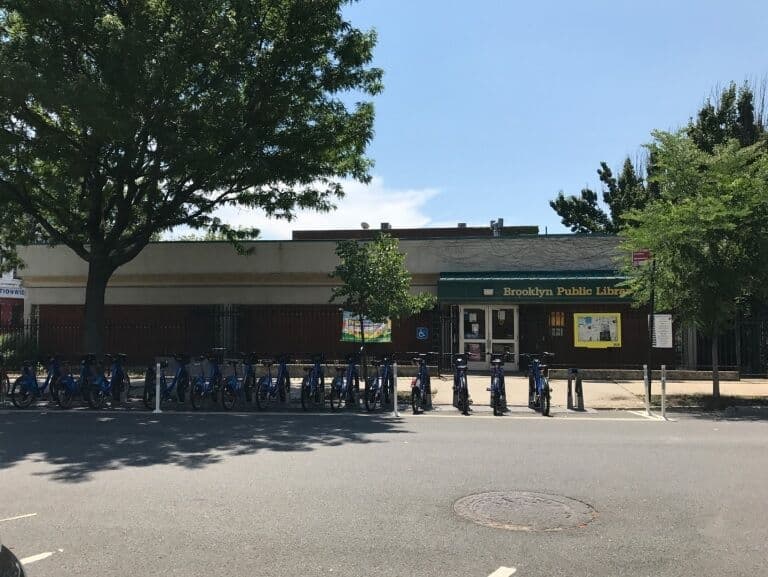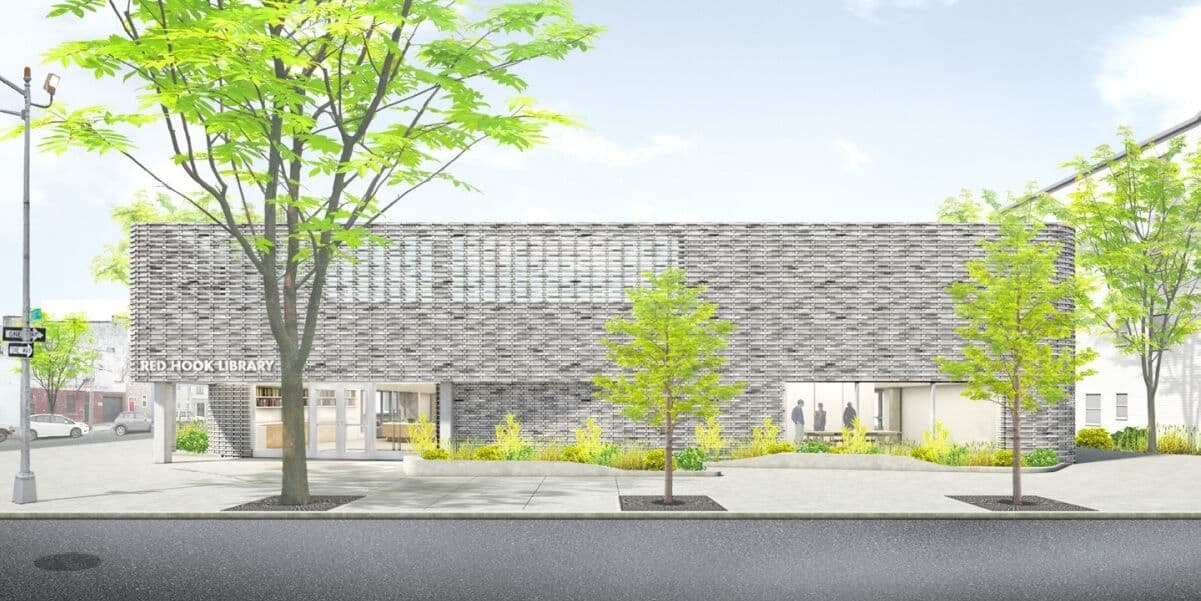The Brooklyn Public Library (BPL) will spend $15 million to build a new Red Hook branch at 7 Wolcott Street. A Community Board 6 Youth/Human Services & Education Committee meeting on October 23 revealed digital renderings of the forthcoming facility, which will replace the circa-1975 library on the same site.
Officials say the demolition will take place in the fall of 2020, and they expect a finished structure by the spring of 2022. During construction, Bookmobiles will stand in for the closed library, with the possibility of additional service through community partners.

The New York City Economic Development Corporation has contracted the architectural firm LEVENBETTS for the job. LEVENBETTS previously designed the Brooklyn Heights Interim Library (which will continue to operate at Our Lady of Lebanon Church until the completion of the new branch on Cadman Plaza West), as well as an under-construction branch in East Flatbush.
In 2015, BPL organized a Red Hook Library Community Engagement Lab at PS 15 to solicit local input on a possible redesign on Wolcott Street. Many Red Hook residents demanded more comprehensive upgrades than the $3.5 million budget for the project would have allowed, necessitating a delay for more extensive fundraising. Councilman Carlos Menchaca’s office has since chipped in, and the project will also make use of $135,000 set aside for the library’s garden and multimedia room through Participatory Budgeting in 2014 and 2015.
A report derived from the Community Engagement Lab has guided the ongoing work of architects Michael Leven and Stella Betts, who will prioritize “flexible spaces” for “different age groups, from seniors to teens to toddlers.” Leven hopes that the new design will communicate “openness and welcoming” in a way that today’s dark, low-slung brick edifice may not.
“We felt that it wasn’t a beacon. People weren’t really seeing the library for what it could be at this critical place in the neighborhood,” Leven said.
Glass will figure more prominently into the facade of the new library, alongside gray brickwork that will feature an “in-and-out” pattern to create a play of light and shadow. Greenery and sidewalk seating will replace the current security fence, and the entrance will move eastward to the corner of Wolcott and Dwight to try to draw in passersby at the busy intersection. A reactivated bioswale garden on the west side of the building (which will include an outdoor classroom, accessible from a side door within the library) and stormwater planters in front will help keep the library dry in Red Hook’s flood zone.

At the meeting, attendees praised the attractiveness of the renderings but wondered whether LEVENBETTS’s airier design could accommodate a sufficient number of books within the footprint of the existing library. Betts acknowledged a challenge of competing demands: the architectural concept, predicated on natural light, will require the removal of some of the library’s perimeter bookshelves to make way for windows. But BPL mandates a particular linear footage of shelf space, and the new design will manage to meet the standard thanks to a number of smaller, freestanding bookcases within the lobby.

As recently as 2014, BPL considered cutting the “underutilized” Red Hook Library in half. If the privatization scheme had gone through, BPL would have leased 3,750 square feet in Red Hook to Spaceworks, a nonprofit that rents work space to artists at affordable rates, for the sake of the local ballet school, Cora Dance. Locals protested the subdivision, and Spaceworks retreated. The new plan appears to mark a victory for Red Hook’s library advocates, who will find technology upgrades and additional community programming at the renovated branch.
Red Hook native Nurys Pimentel now works as a circulation specialist at the library she frequented as a child. “I’m very excited for this new design. I think that we don’t have a lot of attendance in certain things,” she admitted. “Out of all the neighborhood community spaces, we’re probably the oldest one,except for the Rec Center.”
Pimentel believes that, today, many kids prefer the brighter, shinier environment at Red Hook Initiative,the nearby nonprofit, during afterschool hours. “Sometimes I think that’s what it is. It’s just an old building – it’s ‘the same old library,’” she said. “If we have a reinvention, a reopening, something brand new, it’s more inviting.”









